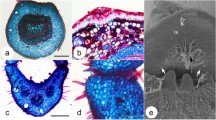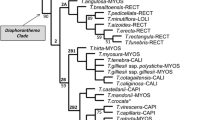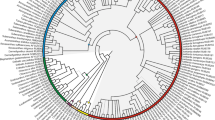Abstract
The genus Persea consists of two subgenera, Persea (known as avocados) and Eriodaphne (known as aguacatillos, avocado-like species). The present study aimed to determine whether the genus Persea is a monophyletic group and whether the division into two subgenera is an artificial one. In conjunction with these goals, a hypothesis of the phylogenetic relationships among Persea species is proposed. Our results suggest that Persea is not a monophyletic group. Two clades of Persea can be recognized. The results suggest that Eriodaphne and Persea should be considered to be independent genera. Various leaf and floral characters contributed for separation into groups. The definition of Eriodaphne is based on fruit color, sessile glands at the base of the stamens, vein prominence and leaf shape. Persea is more closely related to genera Nectandra and Ocotea than Eriodaphne. The 11 species included in Persea are recognized as species. The group is defined by fruit flavor, mature leaf color, number of tertiary divergent veins, and pubescent bracts in the inflorescence. Within this group, a clade of six species in which P. guatemalensis is included is recovered by seed shape, venation pattern relief, and number of fruits per cluster. Moreover, the seed shape supports the separation of P. floccosa and P. zentmyerii. A molecular character analysis is necessary to support the Persea clades proposed herein. Nevertheless the phylogenetic relationships revealed by this study provide new bases for the selection and conservation of the species Persea.
Similar content being viewed by others
References
Allen C.K. (1945). Studies in Lauraceae. VI. Preliminary survey of the Mexican and Central American species. J. Arnold Arbor. 26: 282–434
Barrientos P.A. and López L.L. (2000). Historia y genética del aguacate. In: Téliz, D. (eds) El Aguacate y su Manejo Integrado, pp 19–30. Mundi-Prensa, México D.F
Ben Ya’acov A. 1992. A study of avocado germplasm resources, 1988–1990. II. Findings from the central part of México. Proc. Second World Avocado Congress, pp. 543–544
Bergh B.O. (1961). Breeding avocados at C.R.C. Cal. Avoc. Soc. Yrbk. 45: 67–74
Bergh B.O. (1975). Avocados. In: Janick, J. and Moore, J.N. (eds) Advances in Fruit Breeding, pp 541–567. Purdue University Press, West Lafayette
Bergh B.O. (1992). The origin, nature and genetic improvement of the avocado. Cal. Avo. Soc. Yrbk 76: 61–75
Bergh B.O. (1993). Aguacates. In: Moore, J.N. and Janick, J. (eds) Avances en la Genotecnia de Frutales, pp 687–720. AGT Editor S.A, México D.F.
Bergh B.O. (1995). Avocado. Persea americana (Lauraceae). In: Simmons, N.W. (eds) Evolution of Crop Plants, pp 148–151. Longman Scientific & Technical, London
Bergh B.O. and Bufler G. 1987. Avocado Genetic Resources: Final Report. GIARA B-14, 50 pp.
Bergh B.O. and Ellstrand N. (1987). Taxonomy of the avocado. Cal. Avoc. Soc. Yrbk. 70: 135–145
Bergh B.O., Scora R.W. and Storey W.B. (1973). Bot. Gaz. 134: 130–134
Blake S.F. (1920). A preliminary revision of the North American and West Indians avocados (Persea spp.). J. Wash. Acad. Sci. 10: 9–21
Borys M.W., Leszczyńska-Borys H., Ramírez-Marañon S. and Castro L. (1993). An avocado relative: Beilschmiedia anay (Blake) Kosterm. fruit source. Cal. Avoc. Soc. Yrbk. 79: 125–136
Bufler G. and Ben-Ya’acov A. 1992. Study of avocado germplasm resources, 1988-1990. II. Ribosomal DNA repeat-unit polymorphism in avocado. Proc. Second World Avocado Congress II, pp. 545–550.
Bufler G. and Fiedler J. 1996. Avocado Genetic Resources: Final Report. GIARA B-14, 50 pp.
CICTAMEX. (1990). Descriptores para Aguacate. Fundación Salvador Sánchez Colín, CICTAMEX, S.C., Coatepec Harinas
Clusius C. 1601. Rarioum Stirpum Historia1: 2 AntwerpiaPlantinus.
Davies J., Henderson D., Kobayashi M., Clegg M.T. and Clegg M.T. (1998). Genealogical relationships among cultivated avocados as reveled through RFLP analyses. J. Heredity 89: 319–323
Fiedler J., Bufler G. and Bangerth F. (1998). Genetic relationships of avocado (Persea americana Mill.) using RAPD markers. Euphytica 101: 249–255
Furnier G.R., Cummings M.P. and Clegg M.T. (1990). Evolution of the avocados as related by DNA restriction fragment variation. J. Heredity 81: 183–188
Gama L. 1994. Studies on the systematics and ethnobotany of the subgenus Persea. Ph.D. Thesis, University of California at Riverside California.
Garcia A. and Ichikawa S. (1979). Cytogenetical studies in the genus Persea (Lauraceae). III. Comparative morphological study on 61 avocado strains. Japan J. Breeding 29: 66–76
Garcia A. and Tsunewaki T.H. (1977). Cytogenetical studies in the genus Persea (Lauraceae). I. Karyology of seven species. Can. J. Genet. Cytol. 17: 173–180
Goloboff P.A. 1993. Nona (for Windows). Cladistics@.com.www.cladistics.com.
Hickey L. (1973). Classification of the architecture of dicotyledonous leaves. Am. J. Bot. 60: 17–33
Kopp L.E. (1966). A taxonomic revision of the genus Persea in the Western Hemisphere (Perseae Lauraceae). Mem. N.Y. Bot. Gard. 14: 1–120
Kostermans A.J.G.H. (1952). A historical survey of the Lauraceae. J. Sci. Res. 1: 83–95
Litz R. 2001. Fusión de protoplastos en aguacate. In: Memorias Primer Congreso Mexicano – Latinoamericano de Aguacate. Uruapan, pp. 145–150.
Lorea F. and van der Werff H. 1997. Familia Lauraceae. Fascículo 56. Flora del Bajío y regiones adyacentes. Instituto de ecología A.C. Centro regional del BajíoPátzcuaro.
Lundell C.L. (1975). Studies of American plants, IX. Wrightia 5: 146–148
Mez C. (1889). Lauraceae americane (monographice). J. Koenig. Bot. Gart. Berlin 5: 1–566, 1-3.
Meissner C.F. 1864. Lauraceae. In: Candolle A.D. (eds), Prodromus Systematic Naturalis Regni Vegetavilis. 15: 1–260.
Miller P. (1768). The Gardeners Dictionary, 8th ed. C. Rivington, London
Nixon K.C. 2002. Winclada. Cladistics@.com.www.cladistic com.
Nees von E.F.C.G.D. (1836). Systema Laurinarum. Sumbitibus Veitii et sociorum, Berlin
Pliego-Alfaro F. and Bergh B.O. (1992). Avocado. In: Hammersersehla, A.A. and Litz, R.E. (eds) Biotechnology of Fruit Crops, pp 323–334. CAB International Publishing, Wallingford
Popenoe W. (1941). Wild avocados. Cal. Avoc. Soc. Yrbk. 20: 184–194
Popenoe W. and Williams L.O. (1947). The expedition to Mexico of October 1947. Cal. Avoc. Soc. Yrbk. 1947: 22–28
Rhodes A.M., Malo S.E., Campbell C. and Carmer S.G. (1971). A numerical taxonomic study of the avocado (Persea americana Mill.). J. Am. Soc. Hort. Sci. 96: 391–395
Schieber E. and Bergh B.O. (1987). Cal. Avoc. Soc. Yrbk. 71: 199–203
Schieber E. and Zentmyer G.A. 1972. Exploring for Persea in Latin America. Proceedings of the First International Tropical Fruit Short CourseThe Avocado. University of Florida, Gainesville, pp. 16–20.
Schieber E. and Zentmyer G.A. (1978). Hunting for Persea steyermarkii in the mountains of Guatemala. Cal. Avoc. Soc. Yrbk. 62: 67–71
Schieber E. and Zentmyer G.A. (1981). Exploring for “Aguacate de mico” in Central America. Cal. Avoc. Soc. Yrbk. 65: 49–56
Schroeder C.A. (1990). Useful fruits of avocado relatives. Calif. Avoc. Soc. Yrbk. 74: 243–245
Scora R.W. and Bergh B.O. (1990). The origin and taxonomy of avocado (Persea americana Mill. Lauraceae). Acta Horticulturae 275: 387–394
Scora R.W., Bergh B.O. and Hopfinger J.A. (1975). Leaf alkenes in Persearelated taxa. Biochem. Syst. Ecol. 3: 215–218
Scora R.W., Bergh B.O., Storey W.B. and Kumamoto J. 1970–1973. Three factor analysis of essential leaf oils in selected Persea species. Phytochemistry 9: 2502–2507.
Scora W.R., Wolstenholme N.B. and Lav U. (2002). Taxonomy and botany. In: Whiley, W.A., Scaffer, B., and Wolstenholme, B.N. (eds) The Avocado: Botany, Production and Uses, pp 15–37. CAB International Publishing, Wallingford
Smith C.E. (1966). Archaeological evidence for selection in avocados. Econ. Bot. 20: 169–175
Standley P.C. (1920). Trees and Shrubs of Mexico. Contributions from the U.S.A. National Herbarium, Washington, DC
Standley P.C. and Steyermark J.A. 1946. Persea. In: Flora of Guatemala. Fielddiana Botany 24: 330–336.
Storey W.B., Bergh B.O. and Zentmyer G.A. (1987). The origin, indigenous rangeand dissemination of the avocado. Cal. Avoc. Soc. Yrbk. 70: 127–133
van der Werff H. (2002). A synopsis of Persea (Lauraceae) in Central America. Novon 12: 575–586
Williams L.O. (1950). Two new Perseas from Central America. Ceiba 1: 55
Williams L.O. (1953). New Central American Plants. Ceiba 4: 39
Williams L.O. (1977). Econ. Bot. 31: 315–320
Zentmyer G.A. (1991). Aguacate de mico. Cal. Avoc. Soc. Yrbk. 73: 167–172
Zentmyer G.A. and Schieber E. (1990). Persea tolimanensis: a new species for Central America. Acta Horticulturae 275: 386–387
Zentmyer G.A. and Schieber E. 1992. Persea Phytophthora in Latin America. Proceedings of the Second World Avocado Congress, pp. 61–66.
Zentmyer G.A., Schieber E. and Popenoe W. (1987). Early history of the avocado during the time of the Conquistadones. S. Afr. Avoc. Growers Assoc. Yrbk 10: 11–12
Author information
Authors and Affiliations
Corresponding author
Rights and permissions
About this article
Cite this article
Rojas, E., Terrazas, T. & López-Mata, L. Persea (avocados) Phylogenetic Analysis Based on Morphological Characters: Hypothesis of Species Relationships. Genet Resour Crop Evol 54, 249–258 (2007). https://doi.org/10.1007/s10722-005-3808-x
Received:
Accepted:
Published:
Issue Date:
DOI: https://doi.org/10.1007/s10722-005-3808-x




